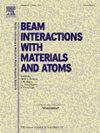Critical re-evaluation of recommended excitation functions of 7 reactions for 61Cu formation
IF 1.4
3区 物理与天体物理
Q3 INSTRUMENTS & INSTRUMENTATION
Nuclear Instruments & Methods in Physics Research Section B-beam Interactions With Materials and Atoms
Pub Date : 2025-04-01
DOI:10.1016/j.nimb.2025.165690
引用次数: 0
Abstract
Re-evaluation of recommended cross sections for seven production reactions for the short-lived β+-emitting radionuclide ⁶1Cu included in the on-line IAEA database for medical applications (Monitor Reactions and Positron Emitters) was performed. One of those reactions is recommended as a deuteron beam monitor reaction: natNi(d,x)61Cu. The re-evaluation included recently published data as well as thoroughly analyzed earlier works available in EXFOR. Where possible, published cross sections were corrected for new nuclear decay data, especially γ-ray abundance or β+ intensity adopted in NUDAT3.0/ENSDF2020. New recommended cross section values and their uncertainties were derived from the Padé fit of the selected data. Relevant data were subjected to correction based on the recently measured ratio of the two dominant γ-rays of ⁶1Cu by Bleuel; an additional Padé fit was performed. Changes up to 20 % of the recommended monitor reaction for deuterons are observed in the 7–10 MeV of incident deuteron energy. Comparison with results of the on-line available TALYS-code calculations is provided and discussed.
对61Cu生成的7种反应的推荐激发函数的临界再评价
对国际原子能机构医学应用在线数据库(监测反应和正电子发射体)中列出的7种短寿命β+发射放射性核素26 1Cu的推荐生产反应截面进行了重新评估。其中一个反应被推荐作为氘核束监测反应:natNi(d,x)61Cu。重新评估包括最近发表的数据以及EXFOR中提供的对早期作品的彻底分析。在可能的情况下,根据新的核衰变数据对已发表的截面进行了校正,特别是在NUDAT3.0/ENSDF2020中采用的γ射线丰度或β+强度。根据所选数据的pad拟合得到新的推荐截面值及其不确定度。根据最近由Bleuel测量的6 - cu两种优势γ射线的比值,对相关数据进行了校正;进行了额外的pad fit。在7-10兆电子伏特的入射氘核能量下,可观察到氘核监测反应的20%的变化。并与在线可用的TALYS-code计算结果进行了比较和讨论。
本文章由计算机程序翻译,如有差异,请以英文原文为准。
求助全文
约1分钟内获得全文
求助全文
来源期刊
CiteScore
2.80
自引率
7.70%
发文量
231
审稿时长
1.9 months
期刊介绍:
Section B of Nuclear Instruments and Methods in Physics Research covers all aspects of the interaction of energetic beams with atoms, molecules and aggregate forms of matter. This includes ion beam analysis and ion beam modification of materials as well as basic data of importance for these studies. Topics of general interest include: atomic collisions in solids, particle channelling, all aspects of collision cascades, the modification of materials by energetic beams, ion implantation, irradiation - induced changes in materials, the physics and chemistry of beam interactions and the analysis of materials by all forms of energetic radiation. Modification by ion, laser and electron beams for the study of electronic materials, metals, ceramics, insulators, polymers and other important and new materials systems are included. Related studies, such as the application of ion beam analysis to biological, archaeological and geological samples as well as applications to solve problems in planetary science are also welcome. Energetic beams of interest include atomic and molecular ions, neutrons, positrons and muons, plasmas directed at surfaces, electron and photon beams, including laser treated surfaces and studies of solids by photon radiation from rotating anodes, synchrotrons, etc. In addition, the interaction between various forms of radiation and radiation-induced deposition processes are relevant.

 求助内容:
求助内容: 应助结果提醒方式:
应助结果提醒方式:


